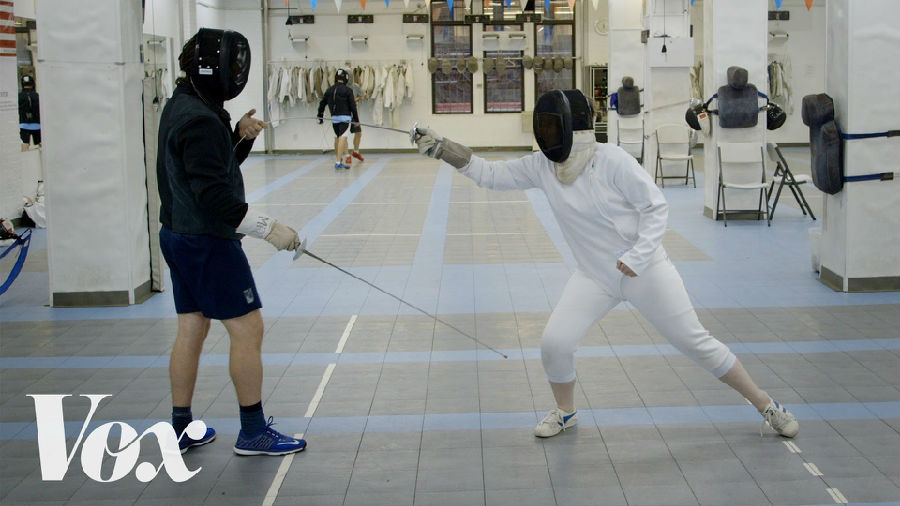(单词翻译:单击)
Most sports in the olympics are really pretty easy to watch.
奥运会上的大多数运动都比较容易看懂。
You cross a finish line, hit a target, jump the farthest, score a point.
要么跑过终点线,要么击中目标,要么跳得最远,就能得分。
But fencing is different.
但击剑不一样。
It’s so incredibly fast and precise,
击剑往往是电光火石间见胜负,动作也非常精细
that even after watching several matches, for the average viewer, it’s hard to understand exactly how a point was scored.
即便已经看过好几场击剑比赛,对于普通观众来说,他们还是很难准确地理解那个分是怎么得的。
This is footage from 3 different bouts at the 2015 world championships.
这是2015年世界锦标赛中3场比赛的录像。
On the surface, they look pretty similar.
乍一看,你会觉得都差不多。
But what you’re looking at is in fact 3 very different events.
但实际上大家看的是三场不同的比赛。
There’s the foil, epee, and sabre.
分别是花剑、重剑和佩剑比赛。
They each have their own weapon and set of rules and their roots can be traced back centuries.
三种比赛都有自己的装备和比赛规则,而且至今都已有数百年的历史。
My only cultural reference for fencing comes from the 1998 remake of the Parent Trap,
我对击剑这项运动的了解仅限于1998年翻拍的《天生一对》里的情节,
so I decided to travel 2 blocks from our NYC office to a veritable fencing oasis in the middle of Time Square, the Manhattan Fencing center.
所以我决定从我们纽约市的办公室出发,穿过2个街区,到时代广场中央一个名副其实的击剑摇篮——曼哈顿击剑中心去一探究竟。
It’s produced 3 Olympians just this year.
就在今年,这里就已经诞生了三明奥运会选手。
That’s me, struggling.
那个是我,在苟延残喘呢。
That’s my very patient coach for the day, Brando Messinese.
对面的是我非常耐心的教练,Brando Messinese。
Perfect. Very good job.
完美。非常不错。
Retreat. Retreat.
后退。后退。
Parry. Reposte.
挡,反击。
But it all happens in a half a second. Yeah it happens pretty fast.
但这一系列动作都要在半秒钟之内完成,是的,是挺快的。
So, where did fencing come from?
那么问题来了,击剑这项运动到底是怎么来的呢?
An early form of fencing for sport can be traced back to ancient Egypt
作为娱乐的击剑最早可以追溯到古埃及,
but fencing, as we know it today, derives from the European duel.
但是我们今天看到的那种击剑其实是源自欧式决斗。
The design of swords evolved from a defense and hunting strategy of cutting and slashing to thrusting because it was far more deadly and effective.
剑的设计也从切和砍这样的防御和狩猎策略发展成了刺,因为刺起来更加致命和有效。
The foil is the lightest of the 3 fencing weapons
花剑在三种击剑装备中最轻,
and it appeared around the 17th century Europe as a practice weapon for the smallsword,
出现于17世纪的欧洲,当时是用作短剑练习,
a fashionable weapon often used in a duel to settle disputes.
就是用决斗解决纷争时通常会用到的一种时兴武器。
Around this time fencing schools were established in Italy, Spain, and France,
大约也就是在那时,意大利、西班牙、法国开始兴建了一些击剑学校,
elevating the practice to a form of exercise and art。
击剑从此变成了一种运动方式和一种艺术。
Foil fencing rules are the most limiting.
在击剑的规则中,花剑的规则最多。
You can only hit the torso and back and only with the tip of the foil blade.
你只能用剑尖刺对手的躯干和背部。
This is where the term touche or (touch) comes from.
术语touche或(触摸)就是这么来的。
In the 19th century a sturdier weapon called the epee was introduced.
在19世纪,所谓“重剑”这种更坚固的武器被引入了这项运动。
I would say for a first time viewer of fencing, the easiest one to watch is epee.
我得说,第一次看击剑比赛的话,重剑比赛是最容易看懂的。
That’s because it’s the slowest of the three events due to the whole body being a target area.
因为重剑比赛中对手的整个身体都是有效范围,所以重剑是三种击剑比赛中速度最慢的。
Fencers are more hesitant to initiate an attack, exposing their whole body to their opponent.
击剑者发动进攻的时候更加迟疑,这样就把整个身体都暴露在了对手面前。
It is also the only of the three weapons where the “right of way” rule is not enforced.
重剑也是三种比赛中唯一没有“主攻优先得分权”规则的比赛。
What’s the “right of way?”
什么是“主攻优先得分权”呢?
Well, in a classic duel, the only way to win if you’re attacked first is to parry or deflect your opponent's weapon AND THEN riposte or attack your opponent.
在经典的决斗中,如果你先被攻击了,你就只能通过有效抵挡然后进攻并击中才能取胜。
With the epee, simultaneous hits can occur and both fencers will receive a point.
但在重剑比赛中,同时击中对方的情况也是有的,这时,两名选手都各得一分。
And now, the fastest event. The sabre.
接下来我们来说说三种比赛中速度最快的。佩剑。
Sabre is the second fastest sport in the Olympic games after rifle shooting.
佩剑是奥运比赛中速度仅次于射击的项目。
That means the blade is moving almost as fast as a bullet.
这就意味着比赛时出剑的速度几乎是和子弹一样快的。
Instead of just thrusting, the sabre fencers can score on any part of the upper body with slashes and thrusts
除了刺,佩剑的比赛选手横击击中对手上半身任何位置也可以得分,
and because the right of way is enforced, sabre fencers are more incentivized to attack first.
因为佩剑也有“主攻优先得分权”规则,所以选手们会更愿意先发制人。
You’ll immediately recognize the difference between an epee and sabre bout
大家一眼就能看出重剑和佩剑比赛的区别,
because of the shape of the hand guard and speed of play.
因为护手的形状和比赛的速度都不一样。
Fencing holds a special place in Olympic history
击剑在奥运比赛的历史上有着特殊的地位,
because it’s one of only 5 sports to be featured since the first modern games in 1896.
因为它是自1896年首届现代奥运会以来一直存在的5项运动之一。
It was a hugely popular sport.
这是一项非常受欢迎的运动。
Until the 30s, fencing bouts like boxing would take place in theaters.
直到30年代,击剑比赛是会像拳击一样在比赛场馆里举行的。
This of course is where the salute comes from.
显然,这就是赛前行礼这一做法的由来。
In the mid 20th century electricity replaced red chalk to make judging easier.
到了20世纪中期,电取代了红色粉笔,评分便变得容易了。
And between 1900s and the early 2000s, many fencing maneuvers further distanced the sport from it’s dueling roots.
从20世纪21世纪初,许多击剑策略让这项运动和其决斗根源渐行渐远。
Nothing did that more than the "flick."
在这些策略中,又数轻掸最为显著。
People were used to be able to flick their blades on the backs of their opponents.
人们习惯于用剑刃轻弹对手的背部拿分。
But then they changed the timings of the machines and that wouldn't work anymore.
但后人他们调整了机器的时间,这招就不管用了。
Because a flick was so quick, it’s less likely to register as a hit.
因为轻弹的时间太短,就不太可能被判为击中了。
Despite that, foil fencers still attempt this maneuver today.
尽管如此,现在花剑选手也还是会试这招。
The International Fencing Federation and the IOC have done a lot to try and draw outsiders to the sport.
为了吸引外行关注这项运动,国际击剑联合会和国际奥委会可谓是煞费苦心。
At London 2012, the lighting systems alone looked like a techno dance floor
2012年伦敦奥运会上,击剑项目的比赛场地的灯光就营造除了一种电子舞曲舞台的感觉,
and the masks closely resembled daft punk head gear.
而选手们戴的面具也神似笨拙的朋克头套。
But the essence of the sport, a fight between two people remains.
但这项运动的本质,也就是两个人之间的斗争,还在。
If you can just train your eyes to watch split second bouts, it’s really pretty exhilarating to watch.
如果你能训练你的眼睛适应争分夺秒的较量,击剑比赛其实还是挺有看头的。


